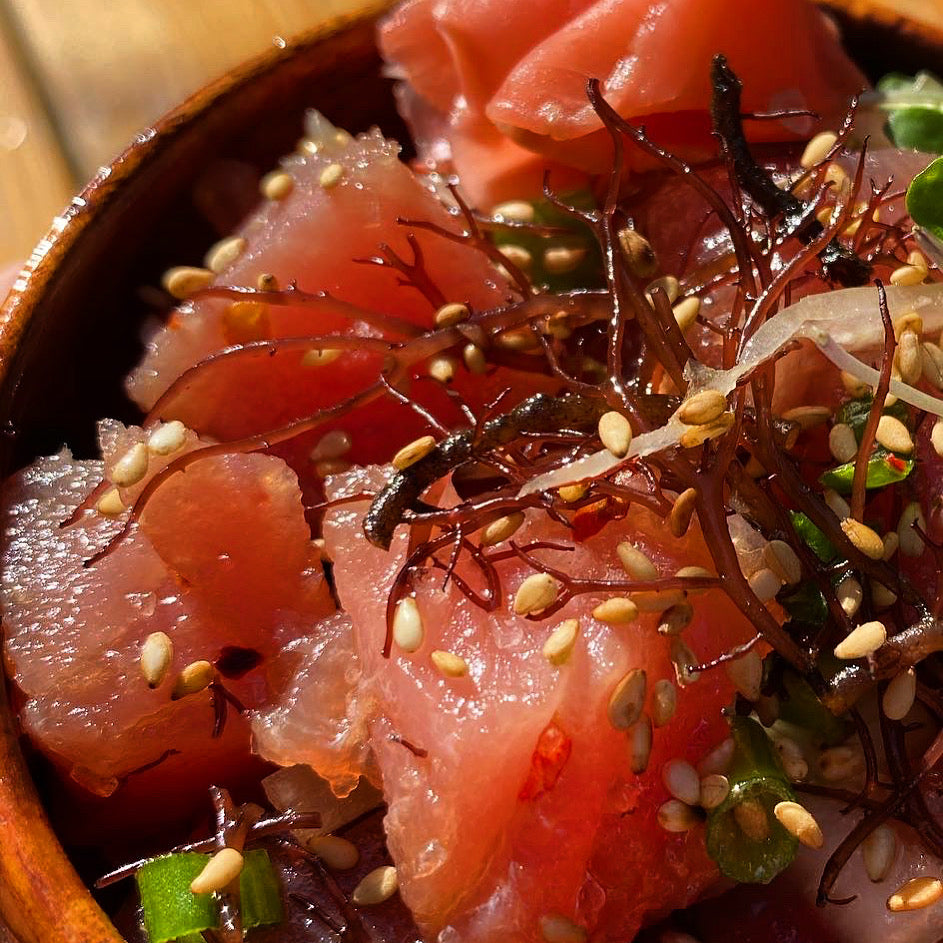Ever wonder why seaweed is a staple in Japanese and Hawaiian style dishes — and why it’s so loved?
From sushi rolls, onigiri to poke bowls, seaweed is more than just a garnish — it’s a flavorful, nutrient-packed ingredient with deep cultural roots. In Japan, seaweed has been part of the diet for centuries, prized for its health benefits and umami flavor. In Hawaii, seaweed (known locally as limu) has long been a traditional food, often eaten raw, pickled, or mixed into dishes for taste and texture.
Beyond tradition, there’s a good reason seaweed keeps showing up in kitchens today. It’s rich in essential nutrients like iodine, calcium, and antioxidants, and adds a savory depth — often called "umami" — that makes dishes more satisfying. It’s low in calories, versatile, and naturally flavorful.
In this blog, we’ll explore why Japanese and Hawaiian style cuisines use so much seaweed, the different types commonly found in both, and simple ways you can start using seaweed at home. If you're looking to add more flavor, texture, and nutrition to your meals, seaweed might just be your new favorite ingredient!
Why do Japanese and Hawaiian style food use so much seaweed?
#1 Cultural roots
Seaweed has deep cultural roots in both Japanese and Hawaiian style food traditions. In Japan, seaweed has been part of the diet for thousands of years. It’s used in many everyday dishes like sushi (with nori), soups (with wakame), and broths (with kombu). Seaweed is not just food in Japan — it’s part of the culture, respected for its health benefits, flavor, and versatility.
In Hawaii, seaweed is known as limu and has been a key part of traditional Hawaiian cuisine and medicine. Native Hawaiians have long used limu in poke (or raw cubed fish), salads, and side dishes. It was often gathered fresh from the ocean and enjoyed with fish and poi. Limu is also important in Hawaiian culture, symbolizing a connection to nature and the sea.
In both places, seaweed isn’t just used for taste — it represents tradition, sustainability, and a deep respect for natural ingredients. That’s why it continues to be a favorite in kitchens across Japan, Hawaii, and now, around the world.
#2 Health and nutrition benefits
One big reason seaweed is so popular in Japanese and Hawaiian food is its amazing health and nutrition benefits. Seaweed is packed with essential minerals and vitamins that are hard to find in other everyday foods.
For example, seaweed is an excellent natural source of iodine, which supports healthy thyroid function and keeps your metabolism running smoothly. It’s also rich in calcium, magnesium, iron, and vitamins A, C, E, and K, making it great for bone health, skin, and overall wellness.
Another big plus? Seaweed is low in calories but high in fiber, which helps you feel full and satisfied without overeating. The fiber in seaweed also supports good digestion and a healthy gut. Seaweed contains natural antioxidants and anti-inflammatory compounds that may help protect your body from harmful free radicals and reduce the risk of certain chronic diseases.
With all these health benefits packed into a small, flavorful ingredient, it’s no wonder seaweed has been a key part of Japanese and Hawaiian diets for centuries — and why it’s worth adding to your meals today!
#3 The flavor magic
One of the main reasons Japanese and Hawaiian food uses so much seaweed is because of the unique flavor it brings — called umami. Umami is the savory, deeply satisfying taste that makes food more delicious. Seaweed, especially types like kombu, nori, and limu, is naturally rich in umami.
In Japanese cooking, kombu is often used to make dashi (soup stock), which forms the base of many soups and sauces. It adds a subtle, earthy depth that enhances everything it touches. Nori is used to wrap sushi or sprinkle on rice for an extra punch of flavor.
In Hawaiian cuisine, limu (local seaweed) is added to poke bowls or eaten fresh for its ocean-fresh taste and texture. Seaweed doesn’t just boost flavor — it balances dishes and brings out the best in other ingredients. That’s the real magic. It’s simple, and natural, and makes meals taste amazing without overpowering them.
Examples of seaweed in Japanese and Hawaiian cuisine
Seaweed plays an important role in both Japanese and Hawaiian cooking, each culture using different types in unique and delicious ways.
Nori
Nori is one of the most well-known seaweeds in Japanese cuisine. It’s dried, paper-thin, and used to wrap sushi rolls or sprinkled over rice and noodles. It has a slightly salty, crispy texture and adds a burst of umami flavor. You can sprinkle Nori Komi Furikake over rice, noodles, or salads to add a delicious mix of umami flavor, crunch, and salty goodness to your meals.
Kombu
Kombu is a thick, dried seaweed used to make dashi, a flavorful broth that’s the base for many Japanese soups and sauces. Kombu gives dishes a deep, savory taste and is also used in pickles and stews.
Wakame
Wakame is a soft, mild seaweed often added to soups, salads, and tofu dishes. It expands in water and adds a light, fresh flavor, and smooth texture.
Limu (Hawaiian island seaweed)
In Hawaiian cuisine, limu is the traditional name for local edible seaweed. It’s often added to poke (raw cubed fish) or served fresh with fish. Limu adds a slightly crunchy texture and ocean-fresh taste that balances other ingredients.
Each type of seaweed brings its flavor, texture, and nutrients, making it a valuable part of everyday cooking in both cultures.
How you can start using seaweed at home
Adding seaweed to your meals at home is easy and a great way to boost flavor and nutrition. You don’t need to be a chef or make fancy dishes — seaweed works well in simple, everyday meals.
Start with Nori, the seaweed used for sushi. You can cut it into strips and sprinkle it over rice, noodles, or scrambled eggs for a quick umami boost. Nori snacks are also great on their own or as a crunchy topping for salads and soups. Next, try wakame, which is perfect for soups and salads. Just soak it in water for a few minutes to soften it, then mix it into miso soup or cucumber salad.
If you enjoy making broth, add a piece of kombu to your water when cooking soup or boiling rice. It adds a rich, savory flavor without much effort. You can also explore Hawaiian-style Furikake seasonings, which often include seaweed mixed with sesame seeds and spices. It’s an easy way to add flavor to rice, fish, popcorn, or vegetables.
With so many seaweed options available in stores, it’s simple to start small and discover which ones you enjoy most in your everyday cooking.
Conclusion
Seaweed is more than just a trend — it’s a flavorful, healthy, and deeply cultural ingredient that has been loved for centuries in both Japanese and Hawaiian style cooking. From sushi rolls wrapped in nori to poke bowls topped with limu, seaweed adds a unique umami flavor that makes food taste better and more satisfying. Start small with easy options like nori sheets or furikake seasoning, and you’ll quickly see how seaweed can bring new life to your everyday meals.
With its balance of flavor, texture, and nutrition, seaweed is a smart, tasty way to upgrade your cooking. So why not give it a try? Add a little seaweed — or a sprinkle of Nori Komi Furikake rice seasoning — to your next meal and enjoy a taste of Japan and Hawaii at home!

